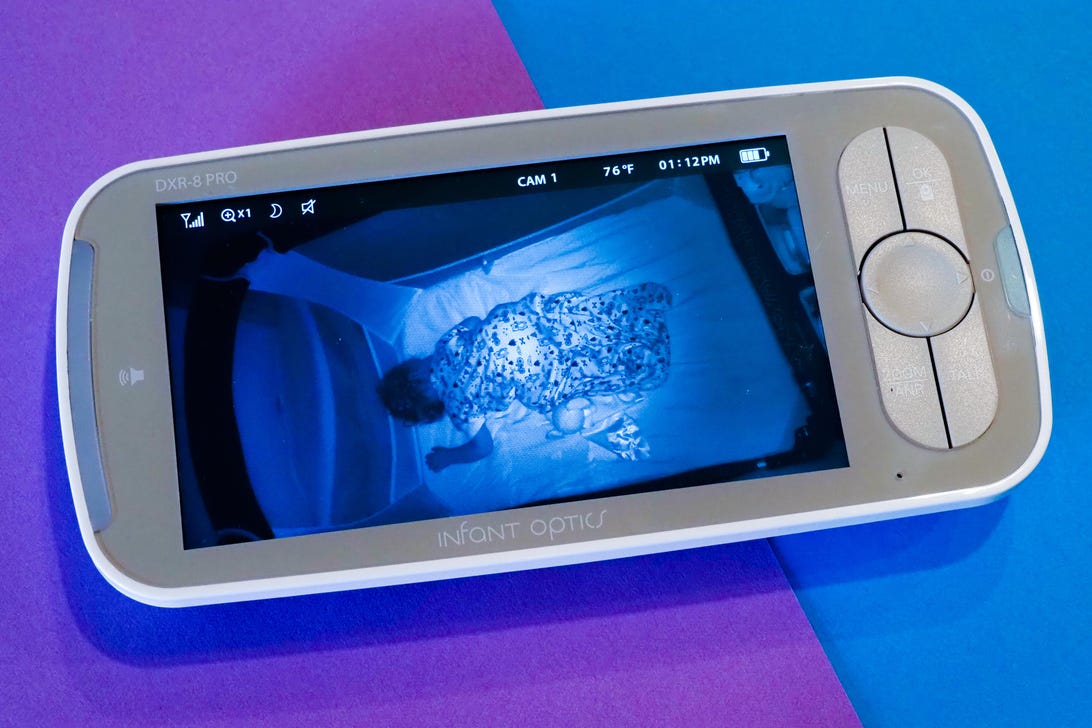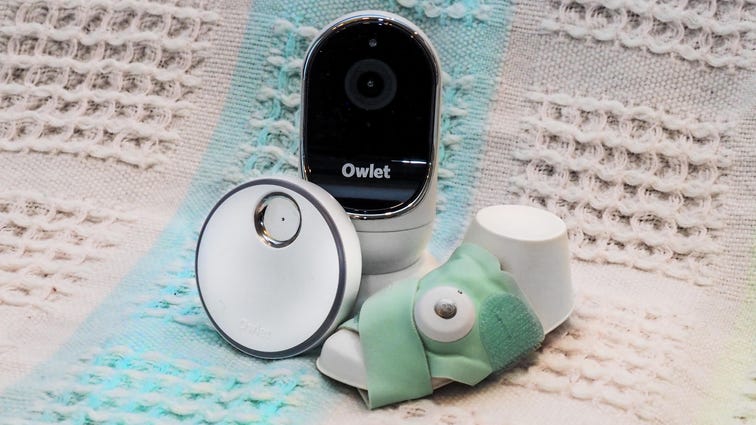Best baby monitors to buy in 2022 – CNET [CNET]
A baby monitor has one job: To keep tabs on your kid when you’re not in the same room. But the baby monitor field is a crowded one these days, with devices that take on much more than their original function — we’re talking a baby security camera with all kinds of features, from a night vision mode to two way audio to wearable monitors. That’s right, you can now buy a monitor to track your baby’s heart rate, breathing and sleep, replace your nightlight and sound machine, record photos and videos, alert you of temperature and humidity fluctuations and more. And the tech behind popular baby monitors has improved over time, with high-definition video, noise-canceling capabilities and smart alerts meant to eliminate some of the guesswork that comes with taking care of a baby and protect your baby’s sleep from disruptions.
Baby monitor comparisons aren’t apples-to-apples. A smart monitor with Wi-Fi connectivity and a dedicated app is a much different product than a non-Wi-Fi video monitor with a separate parent unit. There are also audio monitors without video and, on the other end of the spectrum, wearable devices for monitoring vitals like your baby’s breathing. Your first decision is going to be figuring your which kind is the best baby monitor for you. CNET’s David Priest lays out the four questions to ask yourself before shopping for a baby monitor.
Read on for the pros and cons of each type of baby monitor and our list of the best baby monitors to try. And while you’re here, check out the best baby food delivery services and subscriptions, some baby apps we love, how to get your baby to fall asleep fast and ways to get more sleep when you have a newborn. Plus, are smart bassinets and smart breast pumps worth it?

Wi-Fi baby monitors
Wi-Fi monitors are great if you want to be able to check in on your baby from anywhere. “Range” is not a concern with Wi-Fi monitors, because you can tap into the feed from your phone wherever you get an internet connection. When testing Wi-Fi monitors, I was able to spy on my son from the airport as I prepared to leave on a work trip before he’d woken up for the day. Wi-Fi monitors also tend to have more bells and whistles, with smartphone apps and sleep-tracking capabilities that will appeal to data geeks.
The downside of using a Wi-Fi monitor, besides the potential for a security breach, is connectivity issues. I live in an apartment building with lots of competing Wi-Fi signals and I’m at the mercy of my building’s AT&T contract when it comes to broadband strength. I experienced a lot of trouble setting up the Wi-Fi monitors I tested and once online, several of them lost connectivity in the middle of the night, leaving me with no way to see or hear my son. However, when I tested the same monitors in a large house (with a stronger signal), I experienced no issues. Your mileage with Wi-Fi monitors will vary depending on the density of your living situation and the type of internet connection you use (DSL, fiber and so on). Individual monitors also perform better or worse depending on the quality of their Wi-Fi radio.
Read more: How to turn an old tablet or phone into a baby monitor
Non-Wi-Fi video baby monitors
Because of my internet connectivity issues, I prefer a baby monitor that transmits via radio frequency. Another benefit of this type of monitor is the ease of setup — many are plug-and-play, with no need to download an app or pair anything. A dedicated parent unit frees your phone for whatever else you want to use your phone for and your risk of hacking goes way down. Non-Wi-Fi models also tend to include remote pan, tilt and zoom capabilities, which allow you to adjust the positioning of the camera and get a view of different parts of your child’s room without actually entering it. None of the Wi-Fi monitors I tested could pan or tilt remotely.
The audio and video output of the non-Wi-Fi models did tend to be slightly lower quality than the ones that feed to your smartphone and several of them were just too quiet, even at the loudest volume. And of course, range is a concern with a non-Wi-Fi baby monitor. The ones I tested all promise up to 1,000 feet, but if your house is large or the signal has several walls to traverse, you may still experience a spotty connection.

Wearable smart monitors and audio-only baby monitors
If your budget is tight, an audio-only monitor offers peace of mind without the price tag. Most parents today, however, will opt for a video monitor, especially if you’ll be moving your baby to their own room before the American Academy of Pediatrics’ official recommendation of 12 months.
Wearable devices that monitor heart rate, blood oxygen, breathing, sleep patterns and other metrics bring an added layer of peace of mind, but experts caution that they should be taken with a grain of salt and shouldn’t supersede safe sleep habits. The wearables I tested were bundled with their own video monitor. Smart monitors tend to be expensive and sometimes unnecessarily complicated, but they just might help you get a little extra sleep yourself.
Owlet Cam and Smart Sock (Update: No longer available)

Karisa Langlo/CNET
Update, Dec. 10: After receiving an FDA warning, Owlet stopped selling its Smart Sock in November. You can read more here. For now, we are removing the Owlet from our list of recommended baby monitors. In January, however, Owlet released the Dream Sock, which also pairs with the Owlet Cam.
Original review of the Cam and Smart Sock follows.
Part video baby monitor, part wearable device, the Owlet takes peace of mind to the next level. The camera itself is small and unassuming (with the longest power cord of any I tried, a plus if you’re always on the go). A separate sock-like contraption tracks baby’s vitals with a built-in pulse oximeter, which communicates wirelessly with a base station and alerts you if heart rate or oxygen levels deviate from normal. The socks come in various colors and sizes (up to 55 pounds) and can fit easily inside footed pajamas — my son barely seemed to notice when he was wearing it. Like other smart monitors, the Owlet app provides you with historical data for your child’s vitals. It doesn’t record video though, so if you miss something, you won’t be able to hit rewind.
Features: The Owlet’s heart rate and oxygen tracking is a godsend for a lot of anxious new parents, and even though the Owlet Smart Sock is not a medical device — nor does it prevent SIDS — it really does help you relax when you can watch the graph of your newborn’s heartbeat right on your phone. (That is, if you don’t experience false alarms. For the record, I didn’t.) Push notifications for movement and noise can be turned on or off, with sensitivity calibrated to your needs. The peace of mind alone will be worth the steep price for many parents, but there aren’t a whole lot of other features to report, even though this is by far the most expensive baby monitor on this list. However, the Owlet doesn’t charge extra for a subscription to its app features like many of its competitors do — it’s all included.
Setup and mounting: The camera comes on a magnetic base, allowing you to rotate and swivel it to get just the right angle. That said, you’ll probably still want to wall-mount it for the best view. The camera comes with a pretty standard wall mount kit that should only take a few minutes to install. Pairing the Owlet with my Wi-Fi was a bit trickier, and the ease of setup will probably depend on your Wi-Fi signal, proximity to your router and how many competing signals are nearby. In my apartment, I consistently experienced issues with the Owlet’s initial pairing (and you have to do the process separately for the sock!), but it worked like a charm when I tried it in a large house and a condo. And once paired, it stayed connected. If you have trouble pairing like I did, you might have better luck pairing it close to your router, then relocating it to your child’s room once paired.
Battery life: The Smart Sock must be charged approximately every 16 hours of use. I found it was easiest to just charge it every morning on the base station, which doubles as a handy wireless charger.
Audio and video quality: The Owlet’s audio is clear with little background noise. The camera’s field of view is nice and wide, and you can toggle between 360p, 480p and 1080p definition.

![best-baby-monitors-to-buy-in-2022-–-cnet-[cnet]](https://i0.wp.com/upmytech.com/wp-content/uploads/2022/02/49987-best-baby-monitors-to-buy-in-2022-cnet-cnet.jpg?resize=800%2C445&ssl=1)
![disney-plus-to-hike-us-price-by-$1,-reveals-new-marvel,-star-wars-originals-–-cnet-[cnet]](https://i0.wp.com/upmytech.com/wp-content/uploads/2020/12/17525/disney-plus-to-hike-us-price-by-1-reveals-new-marvel-star-wars-originals-cnet-cnet.jpg?resize=300%2C200&ssl=1)
![spotify-ceo-reportedly-confirms-joe-rogan-wanted-racially-offensive-podcast-episodes-removed-–-cnet-[cnet]](https://i0.wp.com/upmytech.com/wp-content/uploads/2022/02/49612-spotify-ceo-reportedly-confirms-joe-rogan-wanted-racially-offensive-podcast-episodes-removed-cnet-cnet.jpg?resize=390%2C205&ssl=1)
![openai-responds-publicly-to-ny-times-copyright-lawsuit:-‘without-merit’-[venturebeat]](https://i0.wp.com/upmytech.com/wp-content/uploads/2024/01/161383-openai-responds-publicly-to-ny-times-copyright-lawsuit-without-merit-venturebeat.webp?resize=390%2C205&ssl=1)